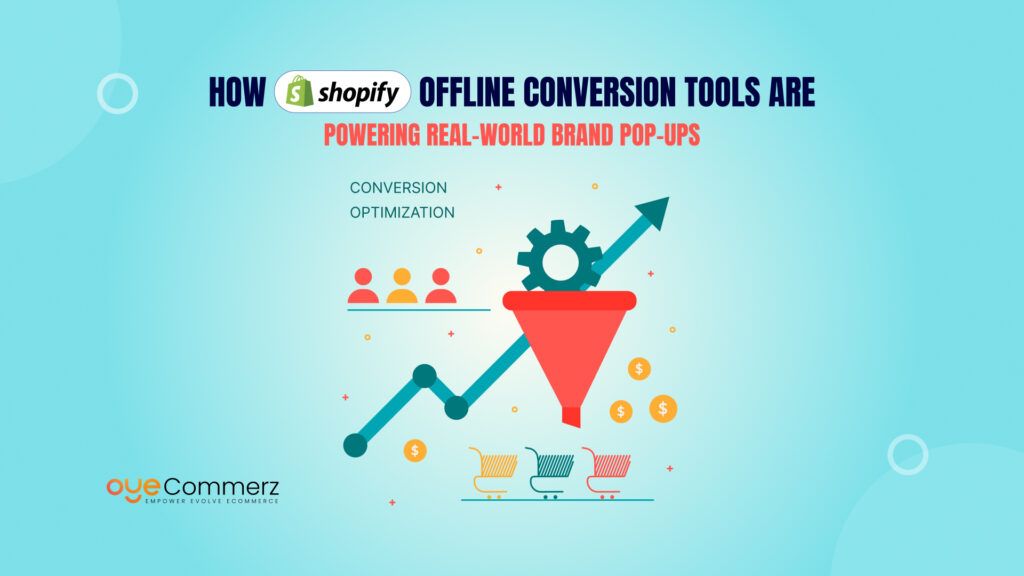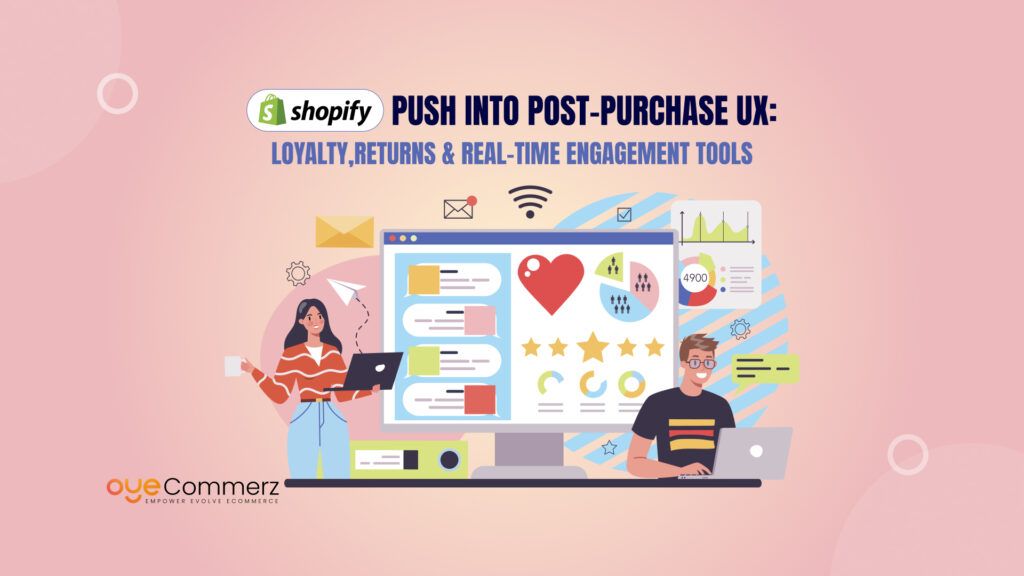The eCommerce world is booming like never before. With more businesses going digital and consumers choosing to shop online, running an online store has become both a smart and necessary move. But with opportunity comes responsibility, especially when it comes to keeping your online store secure.
Today’s online shoppers trust you with their personal information, payment details, and more. A single security lapse can cost you not just sales, but your brand’s reputation. That’s why security isn’t just a tech issue, it’s a business priority.
Among the top platforms, WooCommerce and Shopify often stand out. While WooCommerce offers flexibility, it also comes with its share of risks. Shopify, on the other hand, is known for being secure and hassle-free.
In this blog, we’ll dive deep into the most common WooCommerce security issues and explore why many store owners are making the switch from woocommerce to Shopify for stronger security.
Table of Contents
ToggleWooCommerce at a Glance
WooCommerce is one of the most widely used eCommerce platforms in the world—and for good reason. Built as a plugin for WordPress, it transforms a basic website into a fully functional online store. Its open-source nature, ease of use, and extensive customization options have made it a go-to solution for small to mid-sized businesses looking to build and grow online.
One of WooCommerce’s biggest strengths lies in its flexibility. You’re free to choose your hosting provider, install custom themes, add any number of plugins, and tweak the code to suit your brand. This level of control allows business owners to create truly unique shopping experiences tailored to their customers.
However, that same flexibility can be a double-edged sword. With WooCommerce, you’re not just running a store, you’re also responsible for maintaining the underlying system. That means overseeing updates, ensuring plugin compatibility, choosing a secure host, and implementing your own security measures. Unlike hosted platforms, WooCommerce puts the technical burden on the store owner.
And this is where the cracks often begin to show. When updates are missed, plugins conflict, or vulnerabilities go unnoticed, your store becomes an easy target for hackers.
While WooCommerce can be incredibly powerful in the right hands, its open nature makes it vulnerable if not properly managed. In the sections ahead, we’ll break down some of the most common WooCommerce security issues and why so many store owners eventually seek a safer, simpler alternative.
Common WooCommerce Security Issues
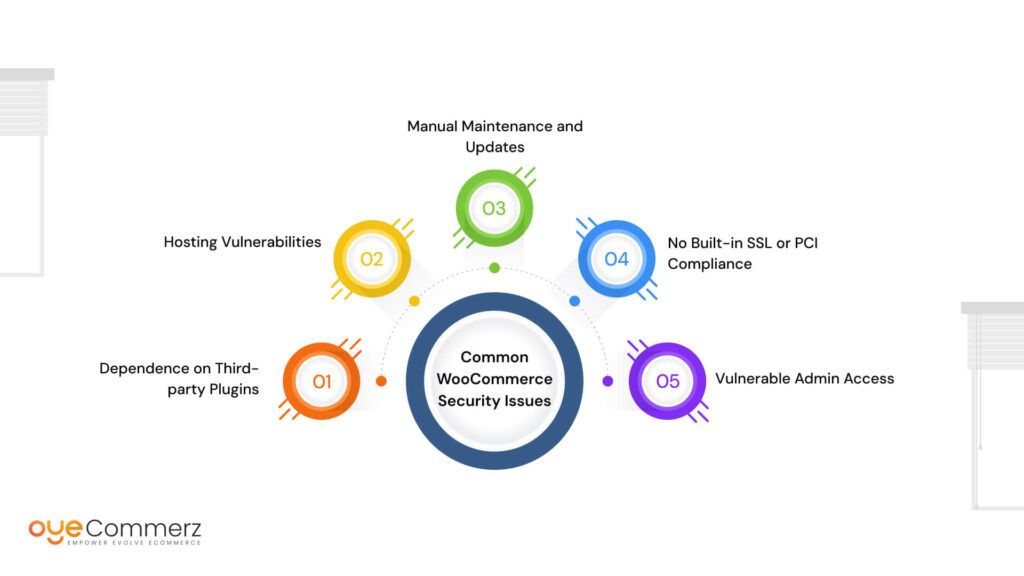
Running a WooCommerce store can feel empowering, but when it comes to security, many store owners unknowingly walk a tightrope. Let’s break down the most common security risks that can turn this powerful platform into a liability.
a. Dependence on Third-party Plugins
Plugins are the backbone of WooCommerce customization. Whether it’s payment gateways, SEO tools, or shipping integrations, plugins extend functionality with ease. However, this reliance also opens the door to risk.
Not all plugins are created equal. Some are poorly coded, outdated, or unsupported, making them easy targets for attackers. Even a single vulnerable plugin can expose your entire store to data breaches or malware.
The more plugins you use, the more likely one of them becomes the weak link in your security chain.
b. Hosting Vulnerabilities
Unlike platforms like Shopify, WooCommerce doesn’t come with built-in hosting. That means your store’s safety heavily depends on the hosting provider you choose.
Weak firewalls, misconfigured servers, and lack of 24/7 monitoring can leave your site exposed. Unless you’re working with a high-quality host that prioritizes security, you’re rolling the dice.
c. Manual Maintenance and Updates
WooCommerce requires regular updates, not just to its own core plugin, but also to WordPress, themes, and every installed plugin. That’s a lot to stay on top of.
The reality? Most store owners delay or skip updates altogether, especially when they fear breaking something. Unfortunately, hackers actively scan for outdated versions and known vulnerabilities. Skipping updates is like leaving your shop’s door unlocked.
d. No Built-in SSL or PCI Compliance
SSL encryption and PCI compliance are non-negotiable for protecting customer payment data. But in WooCommerce, these aren’t provided out of the box.
It’s up to the store owner to install an SSL certificate and ensure PCI standards are met—something that often gets overlooked, especially by newcomers.
Failure to implement these basics doesn’t just risk data, it can damage customer trust and even lead to fines.
e. Vulnerable Admin Access
By default, WooCommerce doesn’t enforce strong admin protections. That leaves the login page open to brute-force attacks, where bots repeatedly try username-password combinations until they succeed.
Without two-factor authentication (2FA), IP blocking, or other safeguards—none of which are built-in, your admin access can be the easiest way in for a hacker.
These WooCommerce security issues don’t mean the platform is bad. But they do reveal how much responsibility falls on the user. For many business owners, that burden becomes too risky to ignore.
WooCommerce Security Breaches Examples
Security vulnerabilities in WooCommerce aren’t just theoretical, they’ve caused real damage to real businesses. These WooCommerce security issues have led to data breaches, financial loss, and shattered customer trust.
In 2021, a critical vulnerability was discovered in the WooCommerce platform itself, along with the WooCommerce Blocks plugin. This flaw affected millions of websites, allowing unauthorized users to access sensitive data like customer names, addresses, and purchase history. The issue was patched quickly, but only for those who updated their sites immediately. Thousands who delayed the update were left exposed.
Let’s take an example- Meera, a boutique owner running a handcrafted jewelry store on WooCommerce. She built her store using free plugins and rarely updated them, fearing site crashes. One day, she woke up to find her site hacked, customer data leaked, and her brand’s reputation in shambles.
Stories like Meera’s are more common than you’d think. Most of them could’ve been prevented with better platform-level security, something Shopify handles for you from day one.
Why Shopify Outshines WooCommerce in Security and Simplicity
Shopify takes a radically different approach to eCommerce than WooCommerce. It’s a fully hosted, all-in-one platform that prioritizes simplicity, reliability, and, most importantly, built-in security. From the moment you sign up, Shopify handles hosting, server maintenance, SSL, PCI compliance, and software updates—so you can focus on growth, not backend issues.
In contrast, WooCommerce users often face plugin overload, manual updates, and the burden of securing third-party tools. That creates gaps in security and drains valuable time.
Here’s why Shopify stands out:
- Hosting: Fully managed by Shopify with no third-party setup.
- SSL & PCI: Enabled by default, no manual configuration.
- Plugins & Apps: Strictly reviewed apps reduce vulnerabilities.
- Maintenance: Automatic updates for core, themes, and apps.
- Security Monitoring: 24/7 real-time protection by Shopify’s team.
- User Access: Built-in 2FA, permission controls, and activity logs.
For businesses without an in-house IT team, Shopify offers peace of mind and industry-grade protection. You don’t just get an eCommerce platform—you get a secure foundation that evolves with you.
That’s why for most modern businesses, Shopify is the smarter, safer choice.
According to Shopify, stores on their platform processed over $200 billion in sales in 2023 alone, with zero major platform-wide breaches proving the strength and scale of their built-in security infrastructure.
This kind of built-in protection is a major reason why Shopify is often favored by business owners who don’t have dedicated IT support. You don’t need to chase plugin updates or worry about misconfigured servers. Shopify’s infrastructure is designed to be secure by default.
At its core, Shopify’s appeal lies in peace of mind. You run your store, they handle the rest. It’s a platform that lets you sleep a little better at night.
Shopify Security Features That Matters
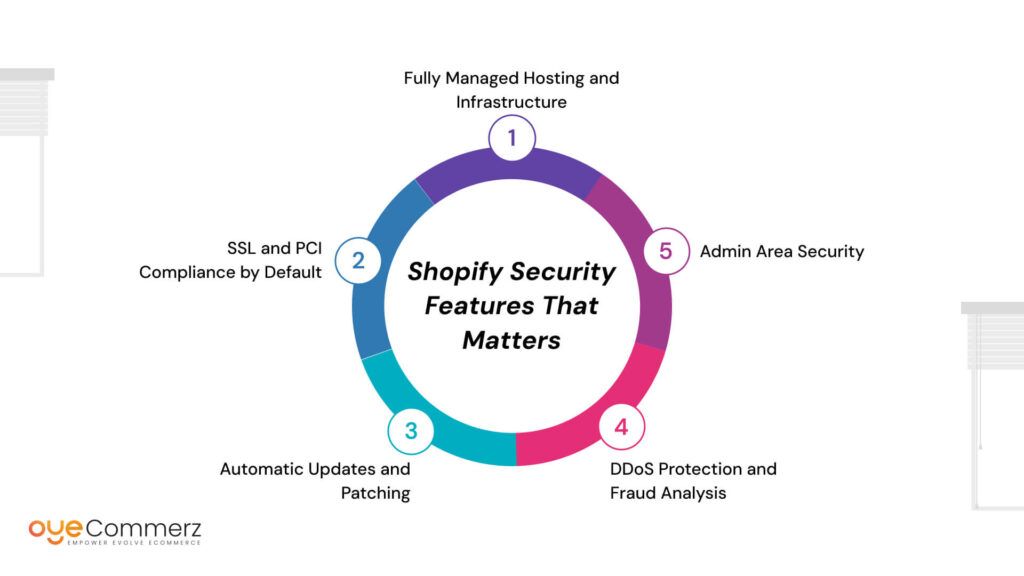
Shopify doesn’t just simplify the eCommerce experience, it builds security into every layer of the platform. Here’s a closer look at the key features that make Shopify a more secure option, especially when compared to the common WooCommerce security issues that many store owners face.
a. Fully Managed Hosting and Infrastructure
With Shopify, you’re never left wondering whether your hosting provider is up to the mark. The platform offers fully managed, enterprise-level infrastructure that’s optimized for speed and security.
Behind the scenes, Shopify runs on a global Content Delivery Network (CDN) to ensure fast load times and enhanced protection against malicious traffic. Real-time server monitoring and robust firewalls guard your store against unauthorized access, all without you lifting a finger.
b. SSL and PCI Compliance by Default
Every Shopify store comes with a built-in SSL certificate, encrypting data during transactions and helping build customer trust. But it doesn’t stop there.
Shopify is PCI DSS Level 1 compliant, which is the highest standard of payment security. You don’t need to apply for certification or install third-party tools, Shopify keeps your store compliant by default, ensuring you’re always in line with industry regulations.
c. Automatic Updates and Patching
Unlike WooCommerce, Shopify doesn’t leave you responsible for plugin or theme updates. The platform handles core updates and security patches automatically, rolling them out behind the scenes with zero downtime.
That means your store stays protected even as new threats emerge—and you don’t have to worry about breaking your site during an update.
d. DDoS Protection and Fraud Analysis
Distributed Denial of Service (DDoS) attacks can take your store offline in seconds, but Shopify includes built-in protection to mitigate such attacks before they reach your site.
Additionally, higher-tier Shopify plans come with advanced fraud analysis tools, which flag suspicious orders based on IP addresses, transaction history, and behavior patterns—helping you avoid chargebacks and losses.
e. Admin Area Security
Shopify offers enhanced admin security features out of the box. You can enable Two-Factor Authentication (2FA) for your staff and yourself, which adds an extra layer of protection beyond just a password.
Admins can also control user permissions, limiting what each staff member can see or do in the backend. Device tracking lets you monitor where and how your store is accessed—great for spotting unusual activity early.
When it comes to eCommerce security, Shopify shifts the weight off your shoulders. You don’t need to be a tech expert or hire one. The platform is built to protect your business while you focus on running it.
Key Takeaways: A Side-by-Side Comparison
When it comes to eCommerce security, the differences between WooCommerce and Shopify are hard to ignore. Here’s a quick side-by-side comparison to help you see where each platform stands:
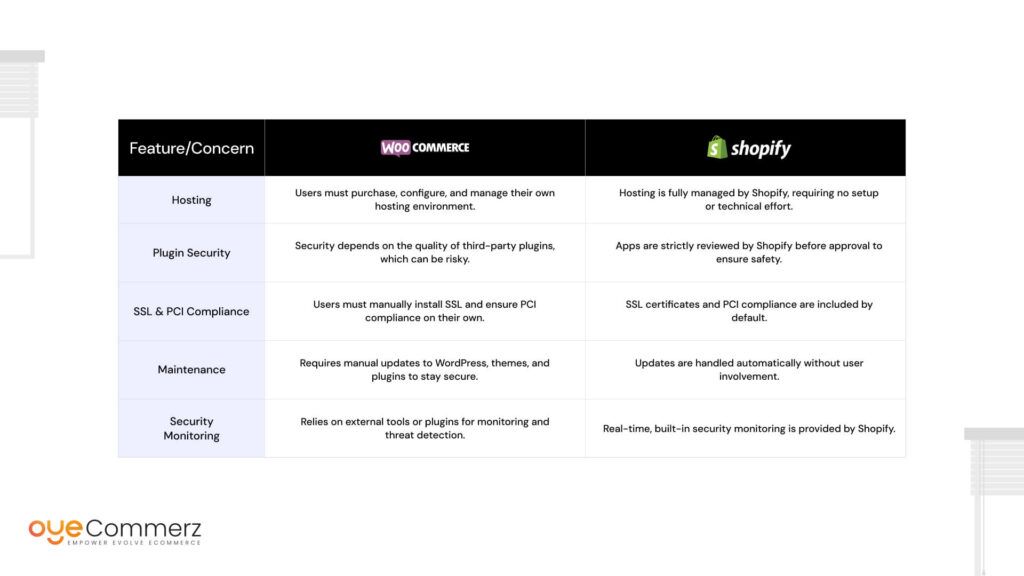
If you’re tech-savvy and want full control, WooCommerce can be powerful, but it comes with greater security responsibilities. Shopify, on the other hand, offers a streamlined, secure environment where peace of mind is part of the package.
Which One is Right for You?
WooCommerce is undeniably powerful. Its flexibility and open-source nature give you the freedom to build almost anything, but that freedom comes with a price: constant upkeep, technical know-how, and hands-on security management.
Shopify, by contrast, is built for ease and peace of mind. It handles hosting, security, compliance, and maintenance behind the scenes, allowing you to focus on growing your business instead of worrying about backend vulnerabilities.
At the end of the day, the right choice depends on your business model and resources. If you have a tech team and crave deep customization, WooCommerce may fit the bill. But if security, stability, and simplicity are your top priorities, Shopify is the safer, smarter bet.
Especially in today’s threat-heavy online landscape, choosing a platform that protects your store, and your customers, shouldn’t be a gamble.
Ready to leave security worries behind?
Switch to Shopify with OyeCommerz – your trusted partner for seamless, secure WooCommerce to Shopify migration.
Let’s build a safer, smarter eCommerce future together.
Contact us now!
Contact to Migrate your Site to Shopify Now
Conclusion
In the fast-moving world of eCommerce, security isn’t a bonus, it’s a necessity. While WooCommerce offers incredible customization and control, it comes with the weight of responsibility. From plugin vulnerabilities to manual updates and third-party hosting risks, store owners need to stay constantly alert. WooCommerce security issues, like outdated plugins or unvetted themes, can leave even the best-built stores exposed. For some, that level of control is worth it. But for many, it’s a risk that could cost their business dearly.
That’s why WooCommerce to Shopify migration is becoming a popular choice among businesses looking for a more secure and reliable environment. Shopify removes the burden with built-in SSL, PCI compliance, automatic updates, and fully managed hosting. It lets you focus on growth, not glitches. For business owners who value peace of mind and rock-solid security, Shopify stands out as a safer, smarter choice.
Frequently Asked Questions
Yes, Shopify is generally safer because it’s a fully hosted platform with built-in security features like SSL, PCI compliance, automatic updates, and real-time monitoring—unlike WooCommerce, which requires manual security management.
WooCommerce’s main security issues stem from outdated plugins, manual updates, and third-party hosting. Without consistent maintenance, stores can become vulnerable to data breaches and malware attacks.
People prefer Shopify for its simplicity, security, and managed hosting. It requires no technical skills, offers 24/7 support, and handles all backend tasks—making it ideal for non-technical business owners.
Shopify is more secure by design. WordPress (and WooCommerce) relies on users to secure and maintain their site, while Shopify handles everything from updates to compliance, reducing the risk of breaches.
WooCommerce can be secure for payments, but only if you actively manage it. You must use PCI-compliant payment gateways, enable SSL, and regularly update plugins and WordPress core files. Security depends on proper setup and maintenance.
Yes, Shopify protects customer data by default. It provides SSL encryption for all stores, maintains PCI DSS Level 1 compliance, and offers real-time security monitoring to safeguard payment and personal information without manual setup.



